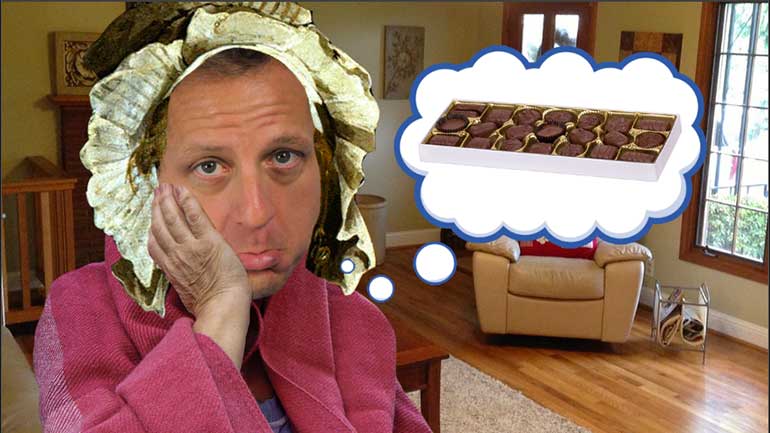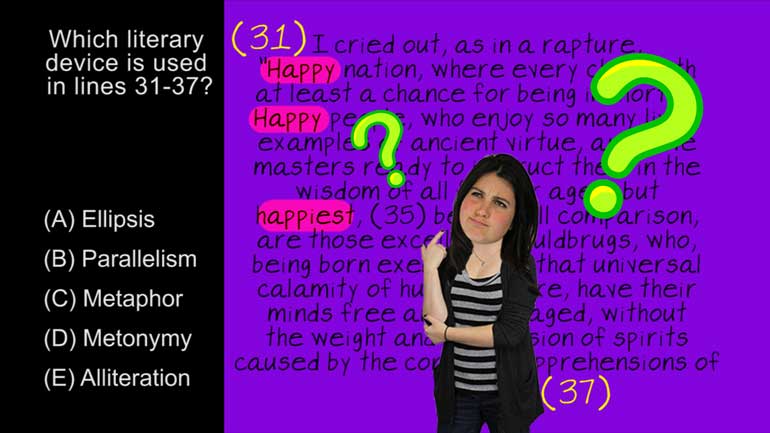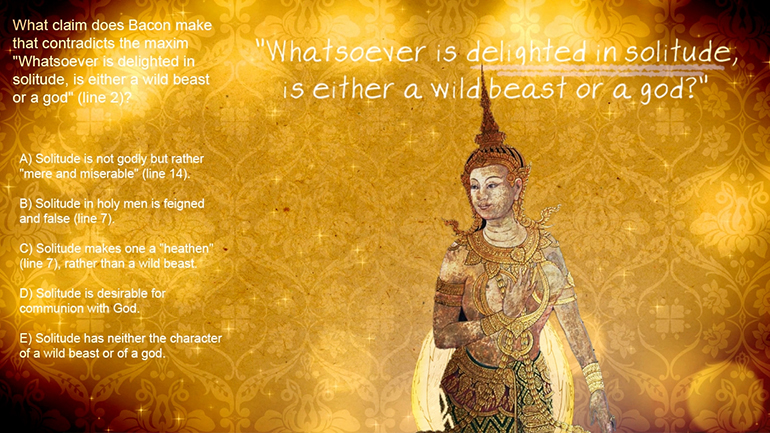ShmoopTube
Where Monty Python meets your 10th grade teacher.
Search Thousands of Shmoop Videos
Physics: Heat Transfer 102 Views
Share It!
Description:
Time to learn about heat transfer. And no, that doesn't mean which Miami Heat players are leaving the team this year.
Transcript
- 00:02
heat transfer thermal energy never chills out my absolute zero [mumbles]
- 00:21
Well is there anything better than a campfire on a cold night the [People gather round a campfire]
- 00:25
smell the warmth the cooking of gooey marshmallow goodness
- 00:30
whenever you light up a campfire it's pretty obvious that there's a lot of [Men appear in basketball attire]
- 00:34
heat going on we have to be careful with fire though we can't just go around and
Full Transcript
- 00:38
willy-nilly burning stuff down Scouts don't give out merit badges for arson [Scouts appear by a campfire]
- 00:43
but when we're sitting six feet away from the fire well how does all that
- 00:47
heat get to us turns out that heat moves around in a few different ways which
- 00:52
shows just how complicated heat can be dead hot there well let's do a quick [Man burns hands on fire]
- 00:59
refresher about what heat is in the first place well heat is the transfer of
- 01:03
thermal energy from one system to another and that transfer part is really
- 01:07
important if energy isn't moving well we don't have any heat you may have [Woman with thermal energy t-shirt sits down]
- 01:12
experienced heat transfer if you've ever touched a pan on the stove you may think
- 01:17
that pan is hot well you may also think I am not smart for touching that hot pan [Man touching pan]
- 01:24
but what do we mean when we say something is hot different hot an object
- 01:30
is hot if it has a lot of thermal energy and we measure the amount of thermal
- 01:34
energy in an object by taking its temperature orally whenever possible
- 01:40
thermal energy comes from wiggling okay physicists might not use the term [Molecules vibrating]
- 01:45
wiggling but all the molecules and atoms that make up an object are constantly [Baby jumping on trampoline]
- 01:49
vibrating like a sugared up two-year-old the more they wiggle the more thermal
- 01:55
energy the object has there are three different temperature scales that are
- 01:59
used right?
- 02:02
what well those are scales you know anyway here in the US and a few small [Map of globe appears]
- 02:07
countries like Belize and the Bahamas we use the Fahrenheit scale the rest of
- 02:13
the world uses Celsius because well it's a simpler scale to understand with [People protesting on road]
- 02:17
Fahrenheit water freezes at 32 degrees and boils at 212 why is there a hundred
- 02:22
eighty degrees spread between those two points
- 02:24
but with Celsius water freezes at zero degrees and boils at 100 it just makes
- 02:29
more sense doesn't it but we can convert Fahrenheit to Celsius
- 02:32
with little math first we subtract 32 from the temperature in Fahrenheit then
- 02:37
we multiply that number by 5 and then divide the result by 9 here's the
- 02:42
equation in all its glory though there are the two temperature [Thermometer rises]
- 02:45
scales that we use in day-to-day life but scientists use a different one
- 02:49
called Kelvin, Kelvin is just like Celsius except zero in Kelvin is zero as
- 02:55
in no thermal energy no wiggling no vibrating nothing and it turns out that [Molecules stop vibrating and stay still]
- 03:02
absolute zero is just about equal to negative 273 degrees Celsius which means
- 03:08
that water freezes at 273 degrees Kelvin and boils at 373 degrees so how do we
- 03:17
convert from Celsius to Kelvin well we just add 273 you know whatever we have [Boy scout appears in classroom]
- 03:21
in Celsius way easier than messing around with all that fahrenheit stuff so
- 03:26
let's get back to how heat actually moves around now people can move around [Scout stood by campfire]
- 03:30
in all sorts of ways we can drive we can fly we can do the worm yeah but heat [Man doing the worm and cheerleaders scream]
- 03:36
moves in three ways conduction convection and radiation
- 03:41
well conduction is a method that we're all familiar with whether we know it or
- 03:45
not conduction is the transfer of heat between two systems that are in direct [Conduction definition appears]
- 03:50
contact with each other say that we're trying to be old school scouts by doing
- 03:54
some blacksmithing yep there used to be a merit badge for blacksmithing but it [Blacksmith hitting iron]
- 03:58
was discontinued in the 1950s because well who needs a blacksmith anymore I
- 04:02
mean I order all my horseshoes from Amazon free shipping and everything but [Scout opens van]
- 04:06
imagine a blacksmith sticking a piece of metal into a fire to get it all hot and
- 04:11
bothered well what happens at a molecular level here well the
- 04:15
temperature of the fire is definitely higher than the temperature of the
- 04:17
metal when the fire comes into contact with the metal the fire sends heat to [Man discussing heat and metal in a field]
- 04:21
the metal bar the particles on the bar start getting their groove on shaking
- 04:26
and vibrating like crazy in fact there's basically a molecular
- 04:29
mosh pit going on and as these molecules slam into other molecules that aren't [Molecules vibrating rapidly]
- 04:35
touching the fire well those particles also start to move faster that keeps on
- 04:40
going down the length of the metal it's like basically a giant molecular chain
- 04:45
reaction you might have experienced conduction in action if you've ever used [Scouts roasting marshmallows]
- 04:49
a metal skewer to roast a marshmallow maybe a prop the skewer on a log for a
- 04:54
minute or two with one end in the fire then try to pick it up and that might
- 04:58
have helped one of your fellow Scouts get a merit badge for first aid when [Scout burns hand on fire]
- 05:01
they treated your second-degree burn on your fingers their conduction doesn't
- 05:06
have to involve fire if you've got an electric stove the burner conducts heat
- 05:10
to a pan because they're in direct contact well that's the key part of [Pan on top of a stove]
- 05:14
conduction objects have to be all touchy-feely with each other but some
- 05:18
materials are better at this whole conduction thing than others which is
- 05:22
why in MIT's exist oven mitts protect our soft tender hands [Man wearing oven mitts]
- 05:26
because they're made of material that doesn't conduct heat very well these
- 05:30
materials are called insulators just like insulation in your home most metals
- 05:35
are good at conducting heat because in addition to atoms that get excited
- 05:39
metals also have free electrons you they're just bouncing around Footloose [Electrons travelling round a shell]
- 05:46
and fancy-free going from atom to atom that extra energy from the free
- 05:51
electrons gets the whole vibration thing going even quicker in insulators though
- 05:57
the electrons aren't going anywhere they're stuck to the atoms like clingy [Boy attached to woman's leg]
- 06:02
little brothers so energy doesn't move around very much at all and the best
- 06:06
insulation of all is a vacuum nope not a dyson we're talking about the absence of [Vacuum appears]
- 06:11
matter no molecules at all like in outer space that's how thermoses work they've
- 06:17
got a vacuum in between the inner wall and the outer wall it's not a perfect
- 06:21
vacuum there are a few molecules of gas popping around but the fewer the
- 06:26
particles the fewer chances for them to get
- 06:29
they're all worked up but when we're talking about gases how does heat move
- 06:33
within them and same question with water it moves differently in fluids and yeah [Scout discussing gases in vacuum]
- 06:38
fluids aren't just things that are wet anything that flows is a fluid in air
- 06:43
well yeah gases can definitely flow like carbon dioxide flow and off dry ice heat
- 06:49
is transferred within fluids using a method called convection let's think
- 06:54
about a car on a hot sunny day like when you come out from a Sunday matinee and [White car drives and parks outside theater]
- 06:59
realize that the inside of your car is about 5 million degrees if you open the
- 07:04
door and look carefully you can actually see the hot air from your interior [Man and woman walk up to car]
- 07:08
rising and shimmering as it escapes but when a fluid gets hot its molecules
- 07:13
freak out just like they do in a solid but in a fluid the molecules aren't in
- 07:18
any kind of rigid matrix their weight less attached to each other so as they [Thermometer rises]
- 07:23
vibrate they get farther and farther apart from each other which makes them
- 07:26
less dense and that's density in terms of the amount of mass per volume not
- 07:30
density like my brain first thing in the morning before I've had coffee when a [Scout holding a cup of coffee]
- 07:34
fluid loses density it rises because it's lighter than the part of the fluid
- 07:39
that's colder and denser well that's how a hot air balloon works the heated gas
- 07:43
in the balloon is less dense than the air outside of the balloon so it's able [Hot air balloon rises into the air]
- 07:47
to float within a fluid the less dense fluid rises and gravity does its thing
- 07:53
on the colder material pulling it down that motion creates circulation if we
- 07:59
have a heat source warming liquid or gas from the bottom the matter close to the
- 08:03
heat rises which makes the colder matter sink bringing it closer to the heat
- 08:08
source which makes it lose density and rise up around and around and round and
- 08:12
round it goes well there's another way convection can occur forced convection
- 08:17
yeah forced convection happens when an outside force pushes a liquid around
- 08:22
there are fancy-pants convection ovens that use this method there's a fan [A chicken appears in an oven]
- 08:27
inside the oven which makes the air circulate keeping the temperature nice
- 08:31
and even inside another way create forced convection is to chug a soda then [Girl chugs a soda bottle at the bar]
- 08:36
give yourself a few seconds to generate that mighty belch that's dying to come
- 08:39
out if chances are the air inside your guts
- 08:43
is warmer than whatever room you're in so as you exhale you're creating [Girl belches at the bar]
- 08:47
convection disgusting convection but still well the key difference between
- 08:53
conduction and convection is movement in conduction only heat moves around from
- 08:59
one object to another but in convection matter moves along [Man licks a frozen lamp post]
- 09:03
with the heat okay one more method of heat transfer and it's the scariest
- 09:08
sounding one radiation yeah now we tend to think of radiation as the thing that [Godzilla appears in Tokyo]
- 09:13
made Godzilla but good news Godzilla isn't real
- 09:18
also not all radiation is nuclear radiation, radiation just means energy
- 09:24
that's transferred by waves or by rays of particles well anything that has a
- 09:30
temperature gives off electromagnetic waves and matter can absorb those waves [A rock appears with electromagnetic waves]
- 09:36
too you've seen this radiation if you've ever seen one of those weird infrared [Scout appears in car garage]
- 09:40
images like this guy this cat we can see how much heat he's given off compared to
- 09:45
the colder background and we can also see how much colder his nose is than the
- 09:51
rest of his body...... all right another example of heat transfer by radiation [Sun beaming and ship travelling in the ocean]
- 09:58
comes from the Sun well the Sun is about 93 million miles away from us but it
- 10:03
creates a huge amount of heat, heat like around 6000 degrees Kelvin and the
- 10:09
electromagnetic radiation generated by this thermal energy is what heats our [Electromagnetic radiation appears from the sun]
- 10:13
planet as hot as the Sun is there's no way for convection to transfer that heat
- 10:19
throughout the solar system that's because most of outer space is of vacuum
- 10:24
remember convection needs fluid there's no fluid in space because well there's [Scout wearing astronaut helmet discussing vacuums in space]
- 10:29
no anything in space it's a vacuum so it's the electromagnetic waves that get
- 10:34
the atmosphere and everything else all worked up the thermal energy transfer [Man sitting on beach and is burnt by sun]
- 10:38
doesn't come from direct contact like conduction or from matter moving around
- 10:43
as it gets excited like convection it's all about the waves here people like I
- 10:48
said before there's nothing better than a nice toasty [Scout standing by campfire]
- 10:50
the campfire and we already talked about how conduction can turn roasting a
- 10:54
marshmallow into a second-degree burn right but would there be convection [Scout burns hand roasting marshmallow]
- 10:59
going on here and how about radiation well what do we need for convection well
- 11:04
for one we need a heat source and I'm pretty sure this pile of burning logs
- 11:08
meets that requirement well then we need fluid and a melting marshmallow well it
- 11:12
doesn't count but air sure does the air molecules that
- 11:15
are coming into direct contact with the fire are experiencing conduction but as [Scout discussing air molecules by campfire]
- 11:21
they rise well the cooler air sinks and then it
- 11:25
heats up plus the warm air rises and excites some of the cooler air around it
- 11:30
oh yeah we're 2 for 3 and radiation well if you've ever been camping on a cold
- 11:36
night you've probably held your hands up to warm them by the fire I'm going to [Scout warming hands by the fire]
- 11:40
assume you're smart enough to not actually touch the fire and convection
- 11:45
is all about rising and sinking air it doesn't really do the whole side to side
- 11:49
thing when you put your hands up to something hot you're benefitting from
- 11:52
the electromagnetic waves radiating from the heat so we've definitely got [Scout warming hands on fire with electromagnetic waves]
- 11:57
radiation going on here as well don't worry though it's highly unlikely
- 12:00
the campfire will turn you into some grotesque irradiant mutant we think and
- 12:05
the campfire shows how heat can be transferred in all three ways at the [Heat transfer ways from the campfire]
- 12:09
same time which is usually the case in fact even snuggling up to someone
- 12:14
involves the conduction of body heat convection going on in the air [Man and woman cuddling on sofa]
- 12:17
surrounding you and radiation coming from well pretty much everything well
- 12:21
there's no getting away from heat which is a good thing and there's no getting
- 12:25
away from physics either even in the scouts there's a merit badge for physics [A scout merit badge appears]
- 12:29
nuclear physics as a matter of fact which might seem kind of sinister after
- 12:33
all why do the scouts need nuclear physics I don't worry about it it's all
- 12:37
part of our plan to take over the world with pinky in the brain and rule with an [Scout discussing nuclear physics and explosion occurs]
- 12:41
iron fist just remember our motto be prepared yeah be prepared for the Scout
- 12:47
uprising yes people be very prepared you
Up Next
When you're about to marry the love of your life, not many things could stop you. However, finding out that your future hubby is keeping his crazy...
Related Videos
Here at Shmoop, we work for kids, not just the bottom line. Founded by David Siminoff and his wife Ellen Siminoff, Shmoop was originally conceived...
ACT Math: Elementary Algebra Drill 4, Problem 5. What is the solution to the problem shown?
AP® English Literature and Composition Passage Drill 1, Problem 1. Which literary device is used in lines 31 to 37?
AP® English Literature and Composition Passage Drill 2, Problem 1. What claim does Bacon make that contradicts the maxim "Whatsoever is delig...




